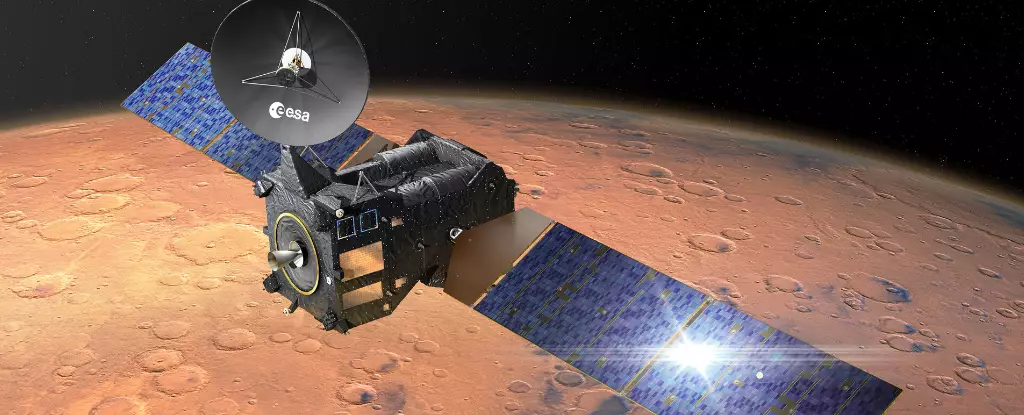In May 2023, an extraordinary event unfolded in the realms of astronomy, art, and community collaboration as the European Space Agency’s (ESA) Exomars Trace Gas Orbiter (TGO) made headlines by simulating a transmission that resembled an extraterrestrial message. This endeavor was part of the artistic and scientific initiative titled “A Sign in Space,” which aimed to engage citizen scientists in cooperation towards decoding this enigmatic signal. Drawing inspiration from Italo Calvino’s Cosmicomics—a collection of imaginative short stories that delve into scientific themes—the project exemplified the intersection between scientific inquiry and creative expression.
The initiative united prominent organizations including the SETI Institute, the Green Bank Observatory, and the Istituto Nazionale di Astrofisica (INAF). This collaboration underscored a commitment not just to cosmic exploration but also to fostering a sense of community among amateur astronomers and enthusiasts globally. As three radio astronomy observatories on Earth intercepted the mysterious message, the true challenge emerged: how to extract meaningful data from the raw radio signals.
Within just ten days, an impressive group of over 5,000 citizen scientists from various corners of the Earth banded together via online platforms to tackle the daunting task of decoding the transmitted signal. Their combined efforts highlighted an extraordinary example of how collective intelligence can yield substantial outcomes in scientific exploration. The power of collaboration shone brightly as these individuals pooled their resources and skills, demonstrating that genuine breakthroughs often rely on diverse contributions rather than solely on academic scholars.
After extensive trials and persistent efforts over a year, it was the duo of Ken and Keli Chaffin—a father-daughter team from the United States—who finally achieved what many could not. Utilizing simulations and analytical techniques, they unveiled the fundamental components of the message, which took the form of five clusters of white dots and lattices on a black backdrop. These shapes were predominantly suggestive of cellular formations, hinting at the origins of life itself. This discovery not only reaffirmed the curiosity surrounding extraterrestrial existence but also pointed to the potential complexities intertwined with interstellar communication.
The visionary behind the project, Daniela de Paulis, is not only a skilled media artist but also a licensed radio operator. Her multifaceted expertise enriches the project, as she integrates artistic interpretation with scientific rigor. As the Artist in Residence at both the SETI Institute and the Green Bank Observatory, de Paulis collaborates with astronomers and computer scientists to craft these intriguing messages, merging artistic vision with complex scientific concepts.
Upon decoding the transmission, on June 7, 2024, de Paulis received a decoded image that showcased five amino acids, underscoring the notion of life’s fundamental building blocks captured in a retro aesthetic. This aspect points to a significant stride in interdisciplinary collaborations—a testimony to how artistic endeavors can channel scientific curiosity while providing a novel lens through which to view the cosmos.
Decoding the Depths of Cosmic Communication
Ken Chaffin’s accompanying message with his decoding results adds another layer to this fascinating narrative. His description of utilizing a Margolus reversible 2×2 block cellular automata to decode the image illustrates a fusion of complex computational methods with biological representations. By inertly linking binary data and molecular diagrams, the Chaffins produced a visualization that offers depth and understanding to the otherwise ambiguous signal.
The decoded molecular structure indicators—showcasing atomic numbers and bond formations—were presented without modifications, emphasizing authenticity in the transmission’s interpretation. This unpolished depiction not only resonates with scientific accuracy but also showcases a deep understanding of chemistry that sparked discussions among professionals in the field. Furthermore, Ken’s insights underline a broader conversation about the nature of decoding itself. His expressions of wonder regarding the transformation of the “starmap” into a visually coherent set of molecules drive the message home: it’s not merely about data interpretation but about the unfolding narrative of cosmic connectivity.
As the initial extraction and decoding phases reach completion, the project’s organizers stand poised for the next step: interpreting the implications of the message. The overarching goals extend beyond simply understanding what was transmitted; they invite reflections on how humanity approaches the notion of first contact with extraterrestrial civilizations. This pivotal moment beckons us to ponder on our readiness for potential communication—be it collaborative engagement, cultural exchange, or the fear of impending threats.
The initiative continues to welcome public participation, encouraging independent analyses and discussions among participants. This democratic aspect of research enables various interpretations grounded in each scientist’s or enthusiast’s unique perspective, nurturing an inclusive atmosphere fueled by curiosity.
In encapsulation, “A Sign in Space” is so much more than a scientific project; it represents an intricate tapestry weaving together art, science, technology, and community engagement. Ultimately, the journey towards decoding extraterrestrial communication illustrates not just humanity’s quest for knowledge, but also the profound relationships that can be forged across disciplines and across the cosmos.


Leave a Reply